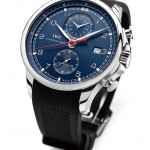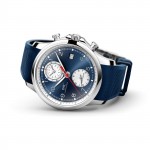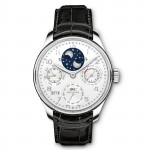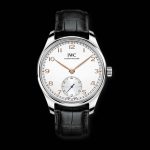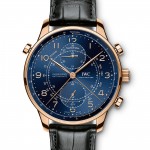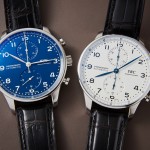Up Close: IWC Portugieser Yacht Club Moon & Tide
Practical and poetic.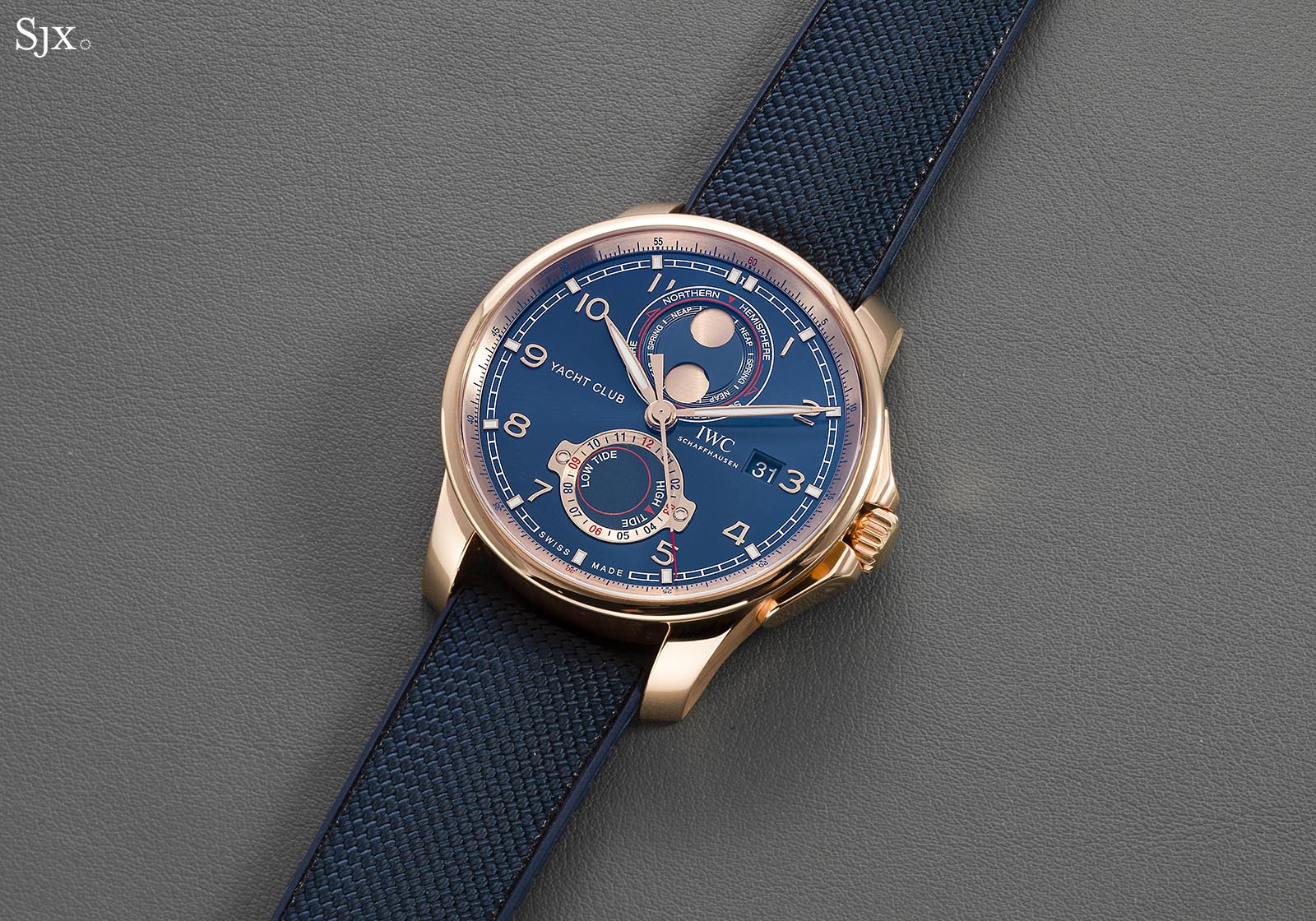
The flagship of IWC’s new Portugieser watches unveiled at Watches & Wonders 2020 is not the most complicated, but it is certainly the most unusual. The Portugieser Yacht Club Moon & Tide is a first for IWC, introducing a brand-new complication to its line-up – a tide indication that tracks the ocean’s ebbs and flows.
Initial thoughts
The Yacht Club Moon & Tide is a big, heavy and shiny sports watch with twin sub-dials, but it is far more interesting than the typical watch in this category (which is almost always a chronograph).
One of the very rare, comprehensive tide-display watches on the market, the Yacht Club Moon & Tide incorporates twin tidal displays, which are useless for most but fascinating, not just because they are rare but also because they are, in essence, an astronomical complication. And the tidal displays are combined with IWC’s trademark double moon phase, making it a bit more compelling.
(But like all tide-indicator watches, the new Yacht Club has a caveat: IWC points out it “works reliably on all coasts with two equally strong high and low tides per day”. It is not a flaw, but just a nature of the complication. More that below.)
At the same time, the watch overall is constructed to IWC’s usual levels of quality, which is to say excellent. The only downside is the rose-gold case, resulting in a steep price tag; hopefully a steel or titanium version comes along (and it probably will).
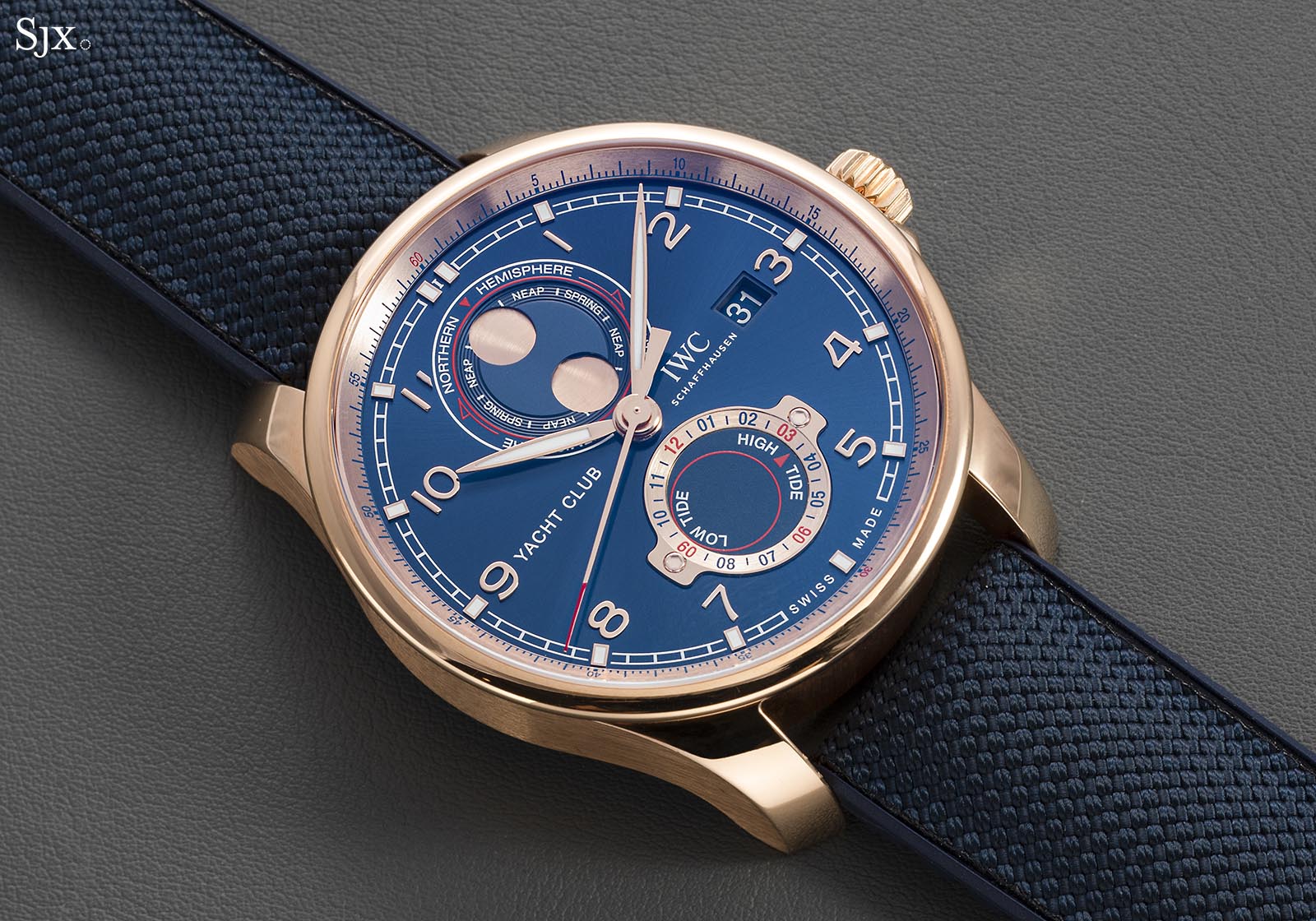
The tidal watch, until now
The tide-indicator complication first appeared in a wristwatch in 1949 when Heuer unveiled the Solunar, which was followed by the Seafarer that combined a tidal display with a chronograph. Like regatta timers for boating, tide-indicator watches were specialised timers created to cater to the growing popularity of recreational and competitive sailing in the 1950s. However, the tidal complication remained relatively rare compared to the regatta timers that had a straightforward application in sailing, making it more commercially successful.
But while regatta timers were designed to countdown to the start of a sailing race, tide indications are astronomical in nature. In fact, they can be seen as an elaboration on the moon phase, because tides are the terrestrial result of the fluctuating gravitational forces exerted by the Moon and Sun on the Earth.
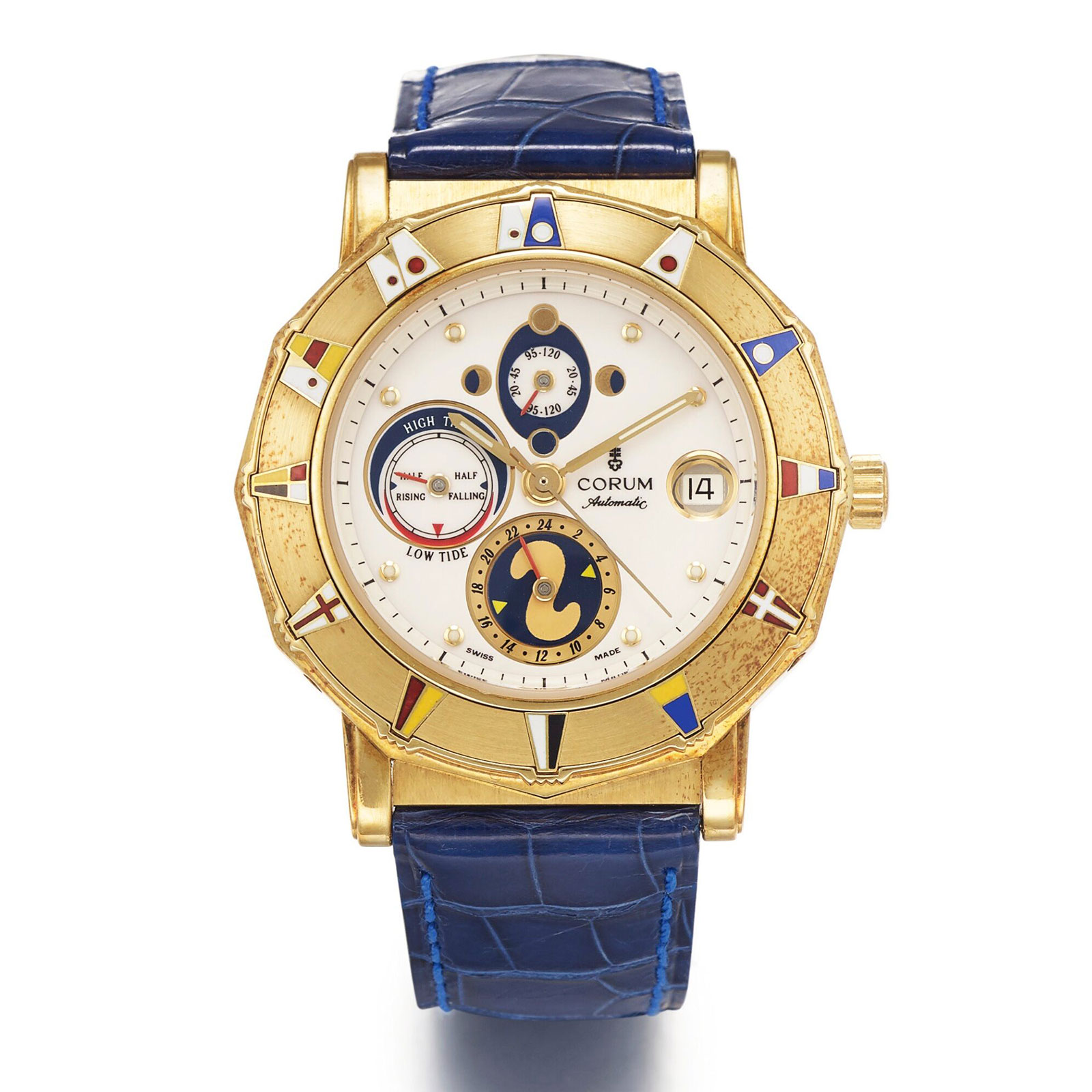
The Corum Admiral’s Cup Tides of 1992. Photo – Sotheby’s
Tide indications should be of broader interest, being useful to fishermen, surfers, sailors, at least in theory. In reality, mechanical tide indications occupy an esoteric area of watchmaking. The complication exists in but a handful of watches spread across a diversity of price points, depending on the complexity of the tide indication.
At the entry level is the affordable Sinn 240 St GZ with a no-frills tide-calculator bezel and a price tag of under US$2,000. At the other end of the spectrum is the artistic Real Moon Tides from independent watchmaker Christiaan van der Klaauw.
But worthy of special mention is the pioneer of the high-end tide indication in modern watchmaking. In 1992, Corum debuted the Admiral’s Cup Tides, which included three tide-related displays and is still in production today as the Admiral AC-One Tides.
That makes the Portugieser Yacht Club Moon & Tide fairly special, being the only tide-indicator watch offered by a major brand today. Additionally, it stands out for being a comprehensive tide indicator, while still maintaining a clean, two-register dial that is reminiscent of the Yacht Club chronograph. But before delving into the new Yacht Club, let’s take a short dip into the world of tides.
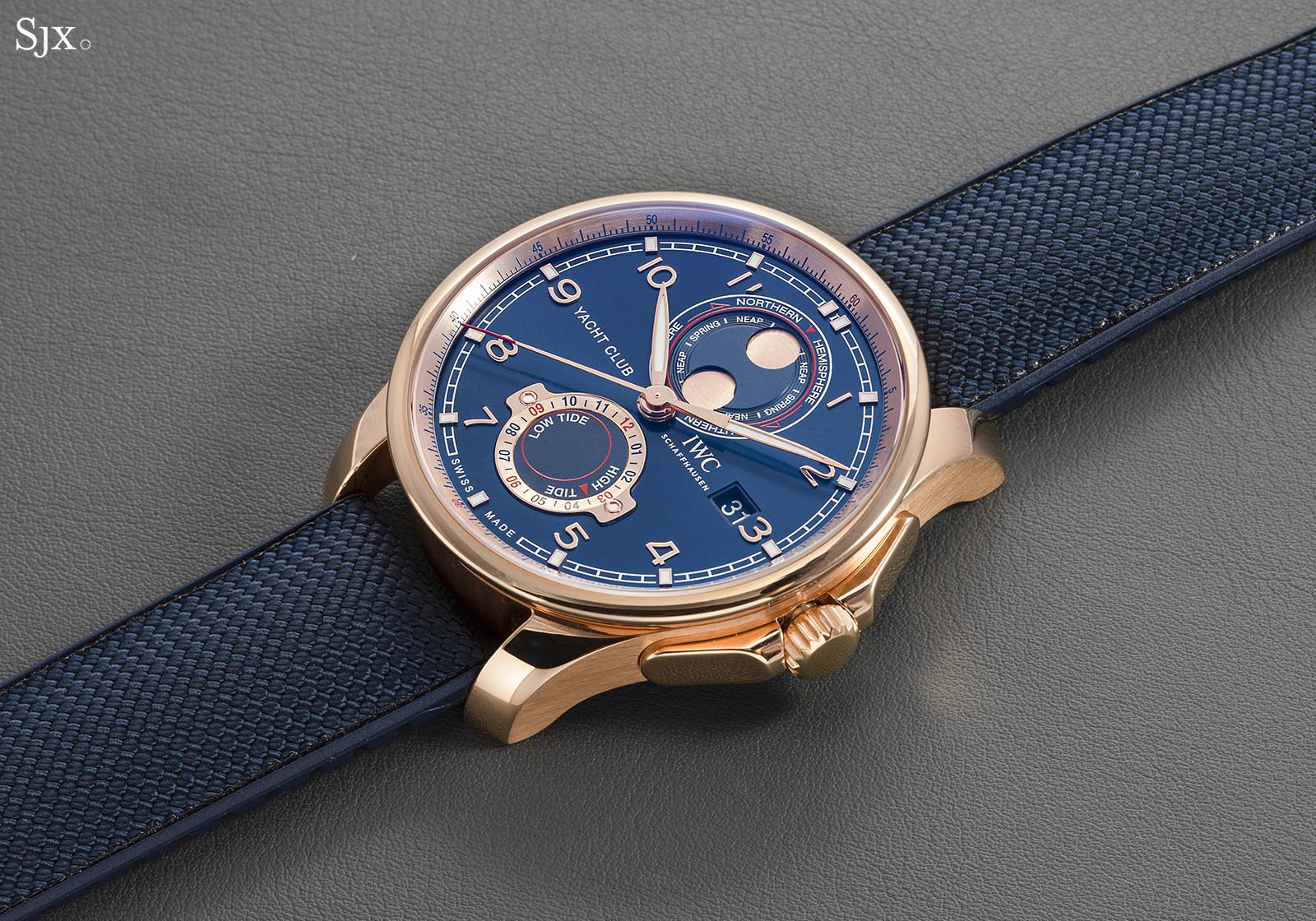
Tide formation
A tide indication is usually accompanied by the moon phase display because the Moon is a major influence on the level of the oceans, more so than the Sun. The gravitational pull of the Moon generates a tidal force that is constant no matter the phase of the Moon. And that tidal force causes the oceans to bulge, on the side of the Earth that is facing the Moon.
But at the same time, the side of the Earth furthest from the Moon bulges because the gravity of the moon is also acting on it, resulting in the water on Earth being stretched into something resembling a rugby ball.
The bulges in the oceans results in high tides around the continents, but not all high tides are created equal. For simplicity, a high tide is often portrayed as being the same everywhere but that’s actually not the case in reality. The bulge in the oceans furthest from the Moon is smaller than the one facing the Moon as the gravitational pull exerted the far side of the Earth is weaker.
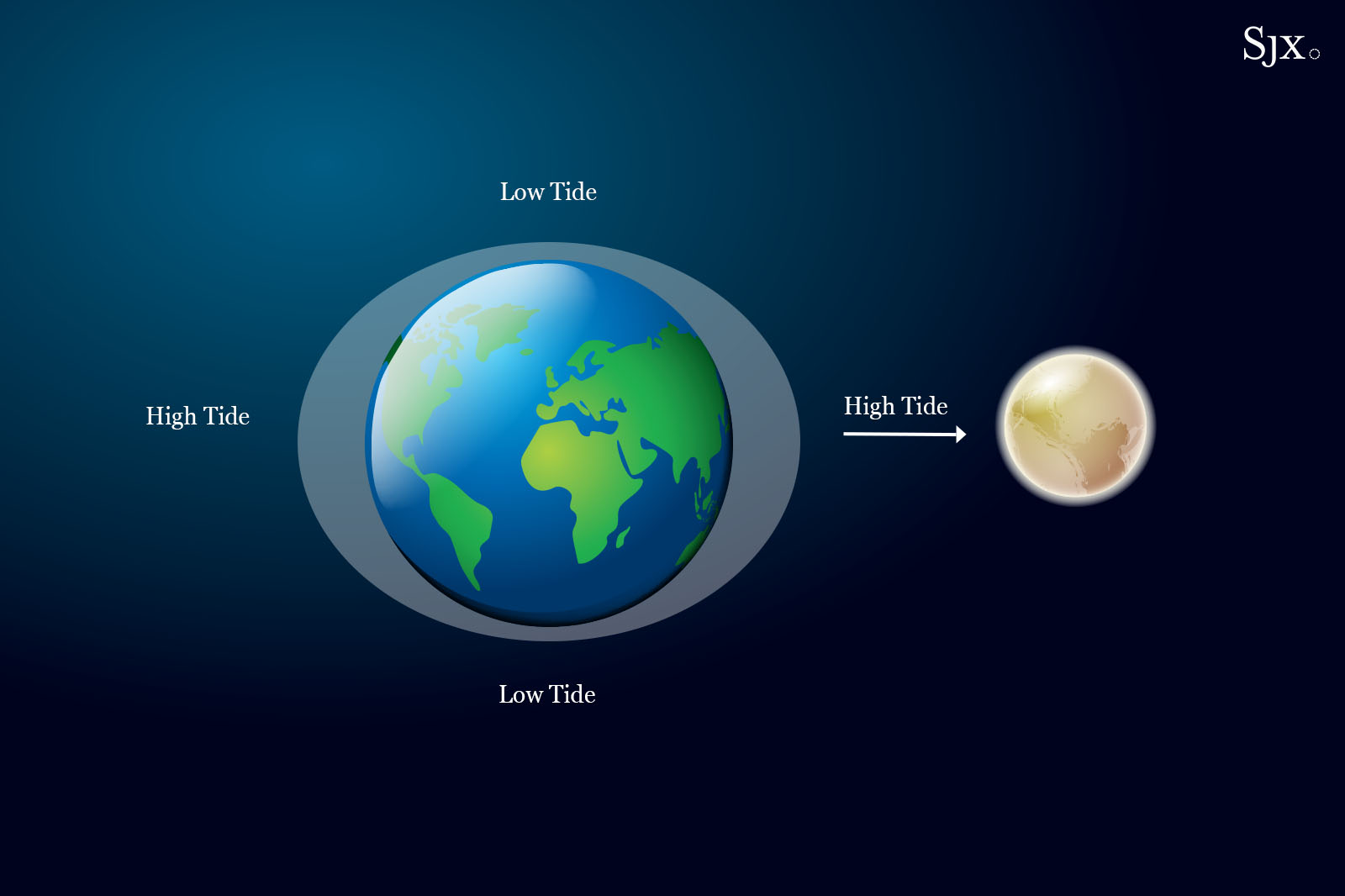
The rugby-ball shape that results from the Moon’s gravitational pull
Because the Earth rotates on its own axis anticlockwise in about 24 hours, it undergoes the cycle of high and low tides twice each day. However, the Moon also orbits the Earth approximately every 29.5 days, roughly equivalent to a calendar month. Thus, during the time it takes the Earth to complete one rotation on its own axis, the Moon progresses a little further on its monthly orbit of the Earth.
As a result, for a fixed spot on Earth to return to face the a fixed spot on the Moon requires 24 hours and 48 minutes, otherwise known as a Tidal Day. And because the tidal cycle happens twice a day, a high tide occurs every half-Tidal Day, or 12 hours and 24 minutes.
Ordinary high and low tides, however, are less extreme than Spring tides that happen when the Sun, Moon and Earth are in syzygy, or linear alignment. Occurring once every full and new moon, syzygy amplifies the gravitational effects on the Earth’s tides, resulting in more extreme tide levels that rises higher as well as fall lower than average.
Conversely, when the Sun and Moon are acting on the Earth at a right angle to each other, a Neap tide occurs. The tidal forces counteract each other, reducing the strength of the average tide due to the opposing gravitational pull. Consequently, high tides are lower, while low tides are higher, compared to the average. While high and low tides are a daily occurrence, Spring and Neap tides occur twice each lunar month, or every 14.76 days.
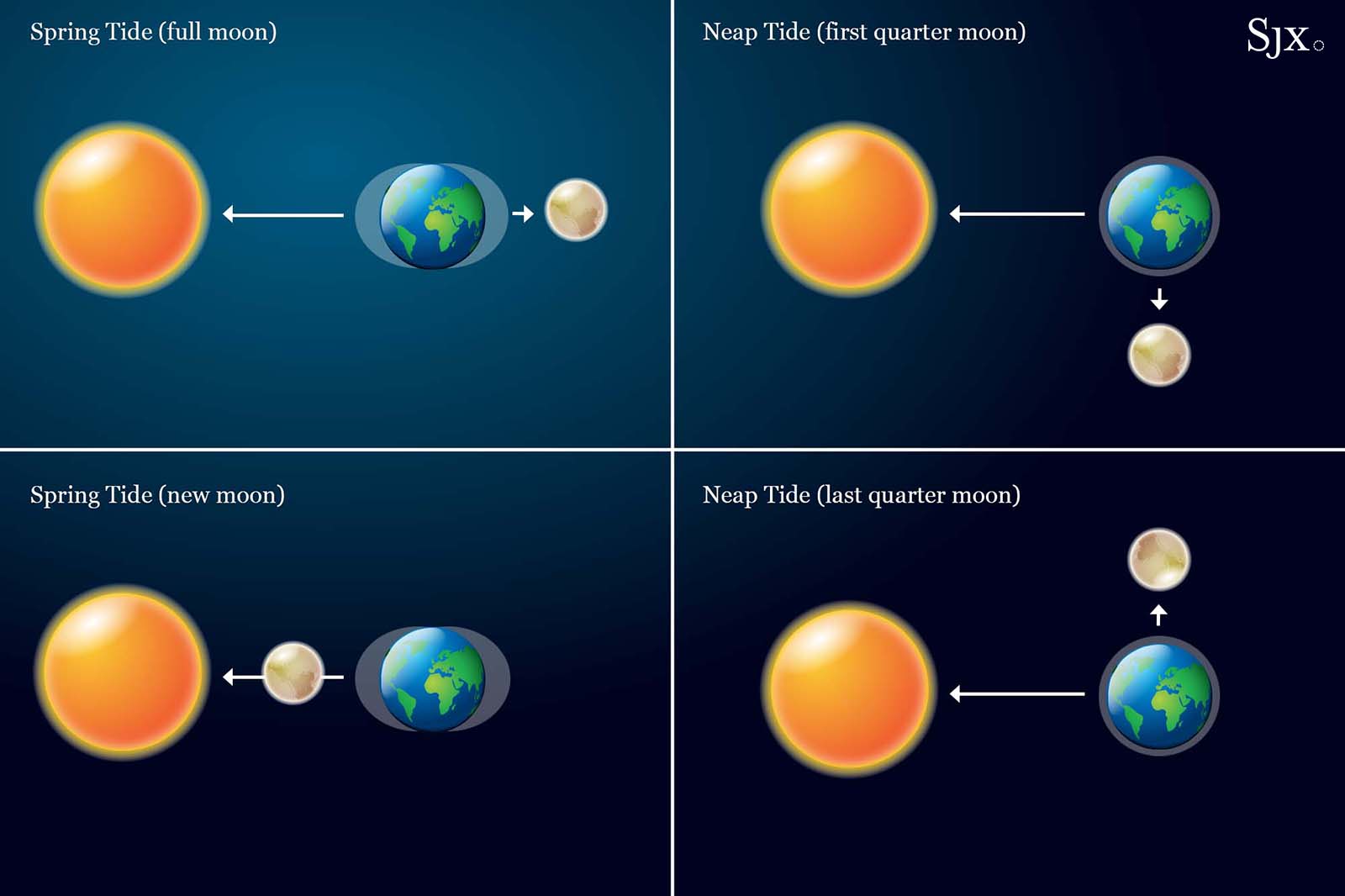
Spring tides occur when the Earth, Sun, and Moon are in linear alignment; when the Sun and Moon are perpendicular to each other and the Earth, the result is neap tides
Just as the oceans bulge on different sides of the Earth due to the influence of the Moon, tides also vary on a smaller scale from place to place, due to not just to the position of the Moon and tilt of the Earth, but also local factors like the shape of the continents, depth of the oceans and so on.
Consequently, tidal patterns can be classified into three categories. Because it is built to cater to the twice-daily tidal patterns found in most of the world, the Yacht Club Moon & Tide is functional for only one category, semidiurnal, where the two high tides each day are generally equal, and ditto for two low tides. Semidiurnal tides occur on most of the world’s coastlines, but not all.
The tidal indicators on the watch do not function if the high and low tides are respectively unequal, a pattern known as mixed tide. Neither do they apply to the third category of tidal patterns, diurnal, which has only a single high and low tide each day.
As a result, the Yacht Club Moon & Tide will be useful in Europe and the east coast of the United States, but not in the American west coast or Indonesia, for instance.
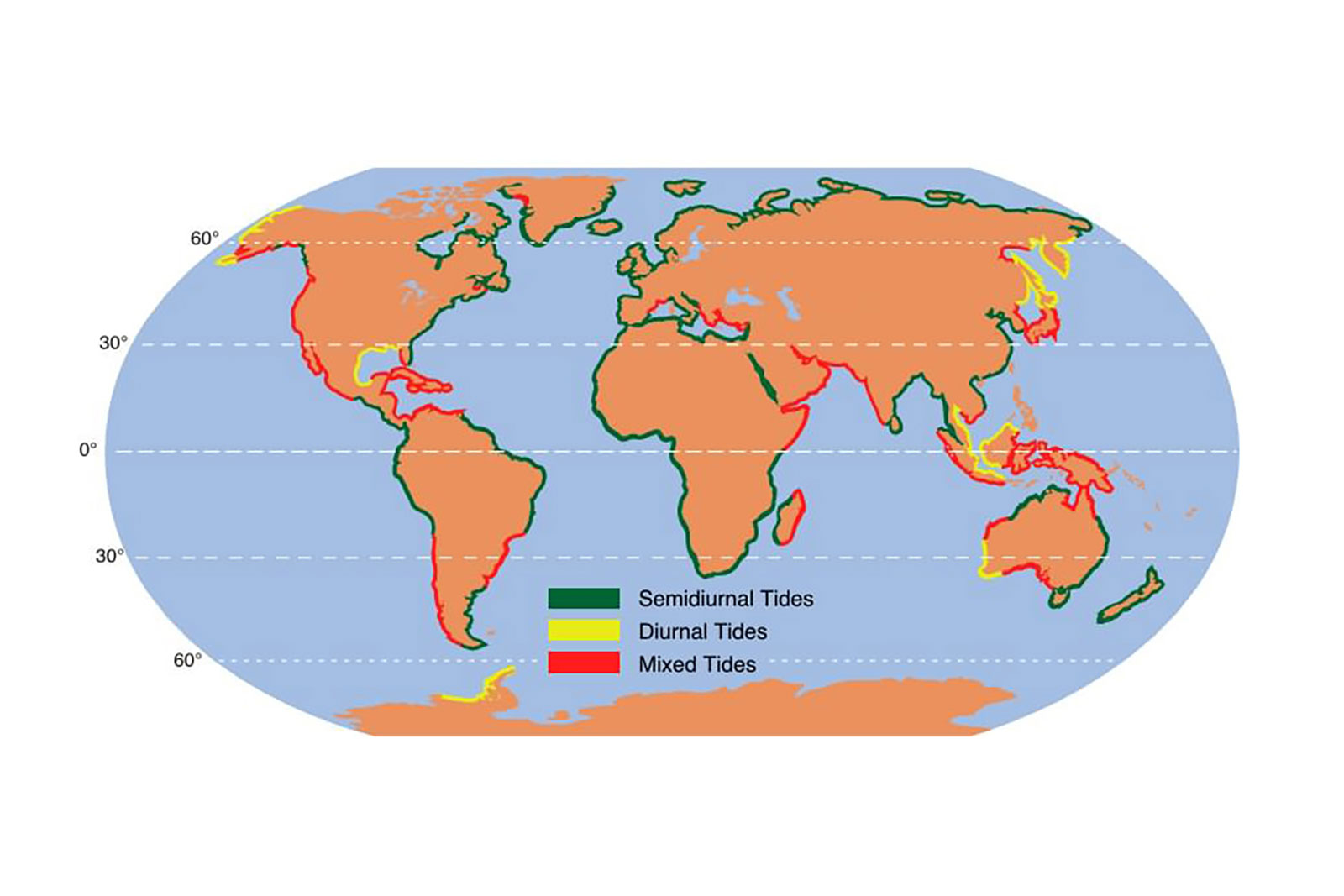
The tidal function of the Yacht Club Moon & Tide only applies to coastlines in green. Diagram – Michael Pidwirny, University of British Columbia, via Wikipedia
Yachting style
The Portugieser Yacht Club Moon & Tide is unique amongst tide-indicator watches as it combines IWC’s signature double moon phase along with a comprehensive tidal display that shows high and low tides, as well as spring and neap tides.
But style-wise it’s conventional and presented in standard Yacht Club format, which was conceived to be a sportier version of the Portugieser. For that reason, the Yacht Club has a greater wrist presence, not just because of its dimensions but also its muscular design with wide lugs, prominent crown guards, and a pronounced rim on the bezel.
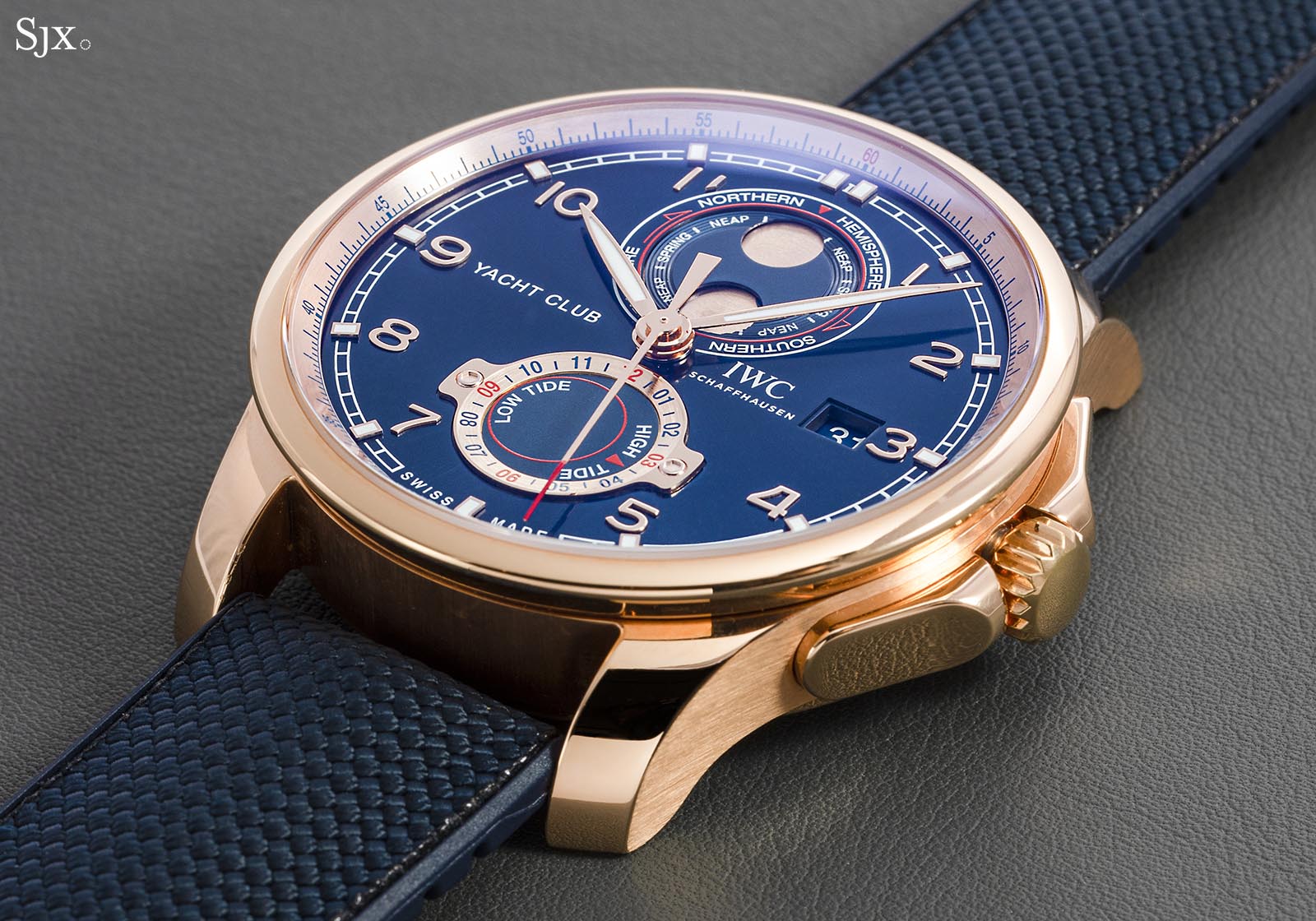
Rendered in pink gold, the watch measures 44.6 mm wide and 14.4 mm high, which is a tad bigger than the already-large Yacht Club Chronograph. Because of it size and weight, the ergonomics are average. It would be far more practical and wearable in titanium or steel instead of pink gold.
The case quality is excellent, as IWC cases almost always are. Though the lines of the case are simple, it is finely finished. And the case is not just heavy, but also extremely solid in construction, as evidenced by the massive case back and the protruding crown guards. That said, the tolerances of crown guards are the one bit of the case that can be improved, as there’s a visible gap between the guards and the case.
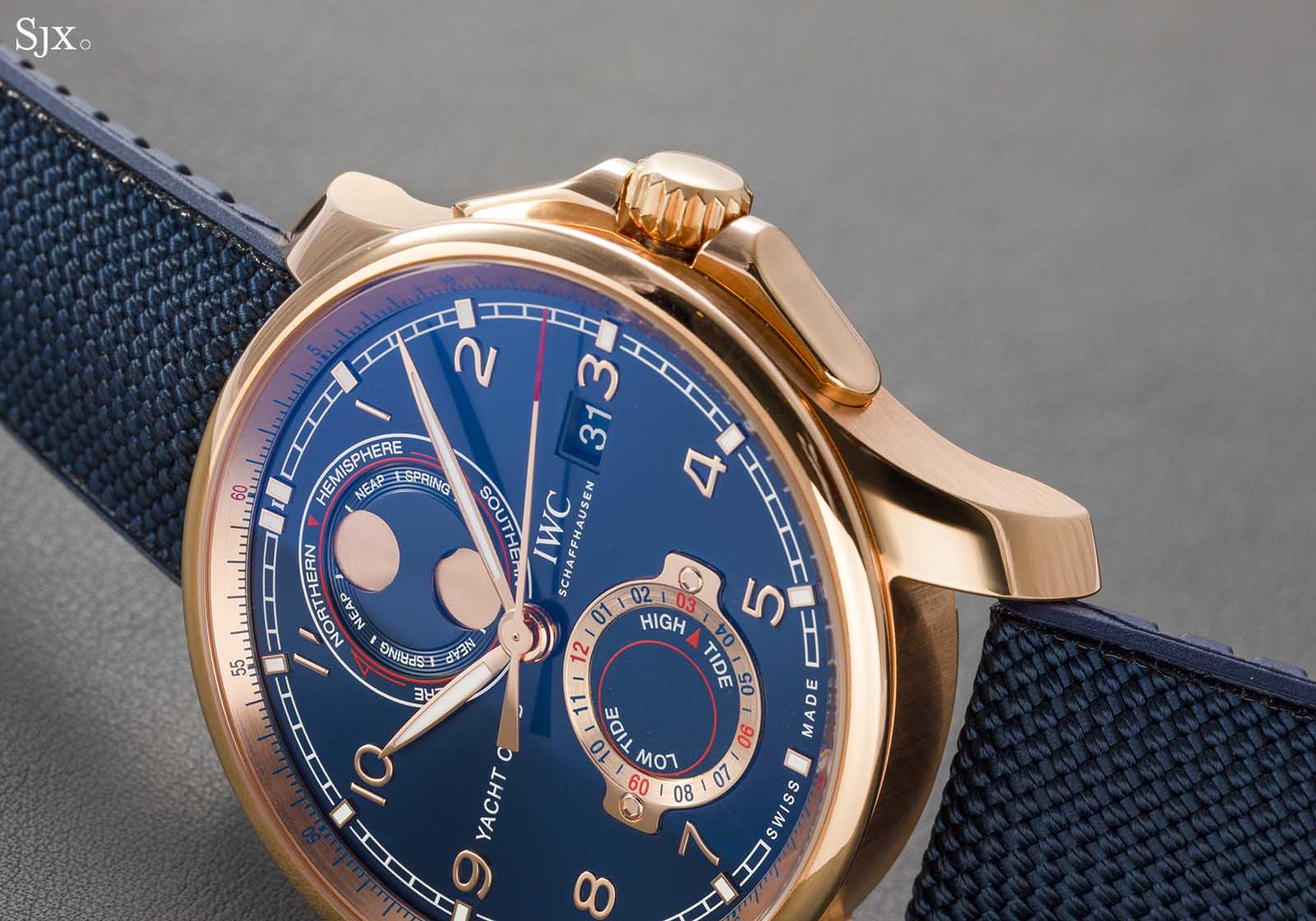
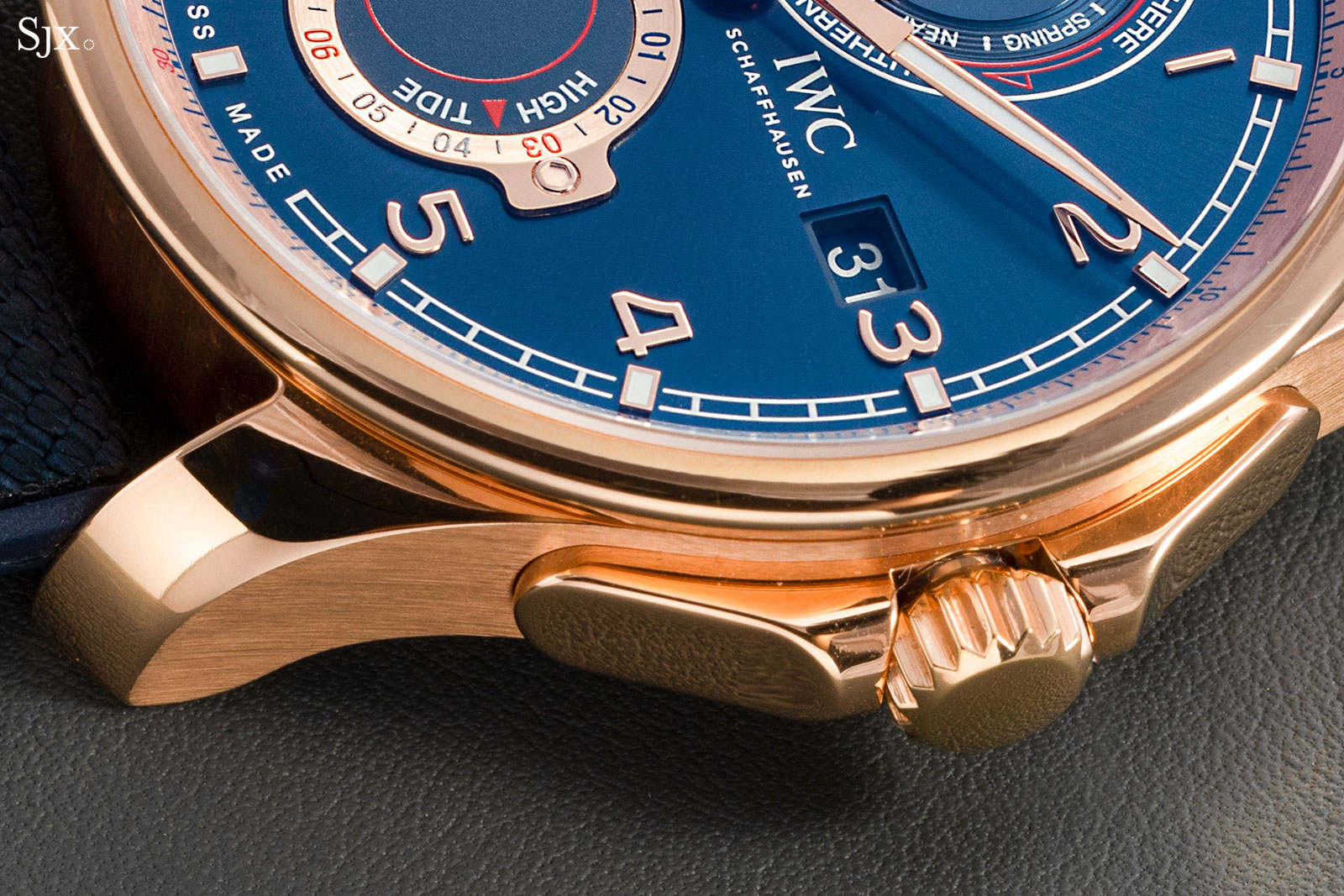
The tidal complication
Symmetrically and logically arranged, dial takes its cues from the Yacht Club Chronograph (which in turn was inspired by the Portugieser Chronograph). Despite being superficially similar to the its chronograph cousin, the Yacht Club Moon & Tide is distinguished by the combination of a pink gold case with the blue dial, a first for the Yacht Club line.
Though the dial is relatively simple in style and detail, it is executed well, up to typical IWC standards. All of the elements look good even up close, ranging from the applied hour numerals to the printed markings. Even the tiny screw that screws the scale for the tide indicator is cleanly finished, revealing only barely-there machining marks.
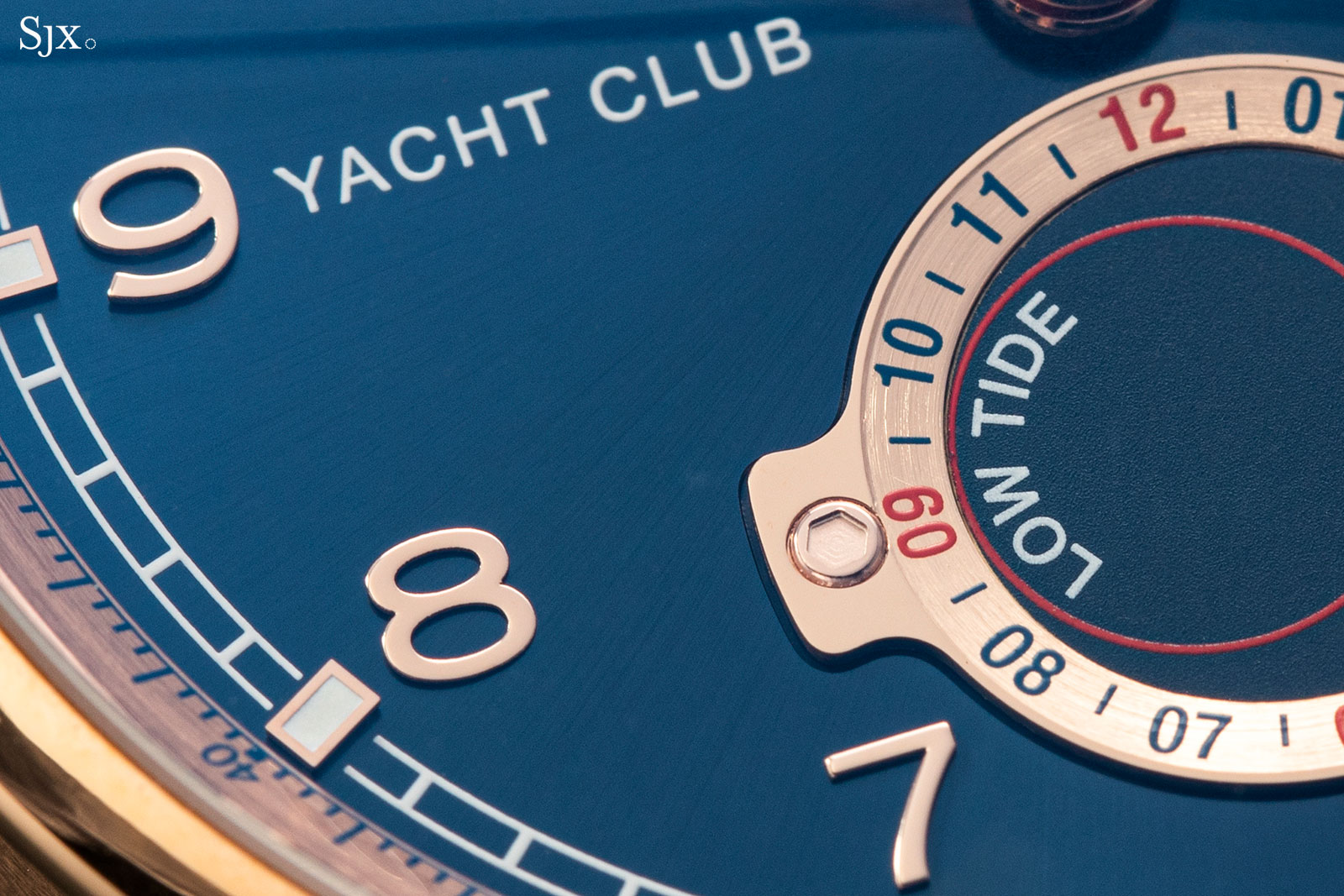
The fairly complex tidal displays have been cleverly streamlined, leaving the dial is clean and easy to read. And the orderly appearance of the dial is helped by its size, which means that the date window doesn’t cut into the three o’clock numeral, though the date does crowd up that side of the dial.
The top sub-dial features a rotating blue disc with two apertures to show the phases of the moon as seen from both the Northern and Southern hemisphere. As with all IWC double moon-phase modules, it has an accuracy of a day in 577.5 years.
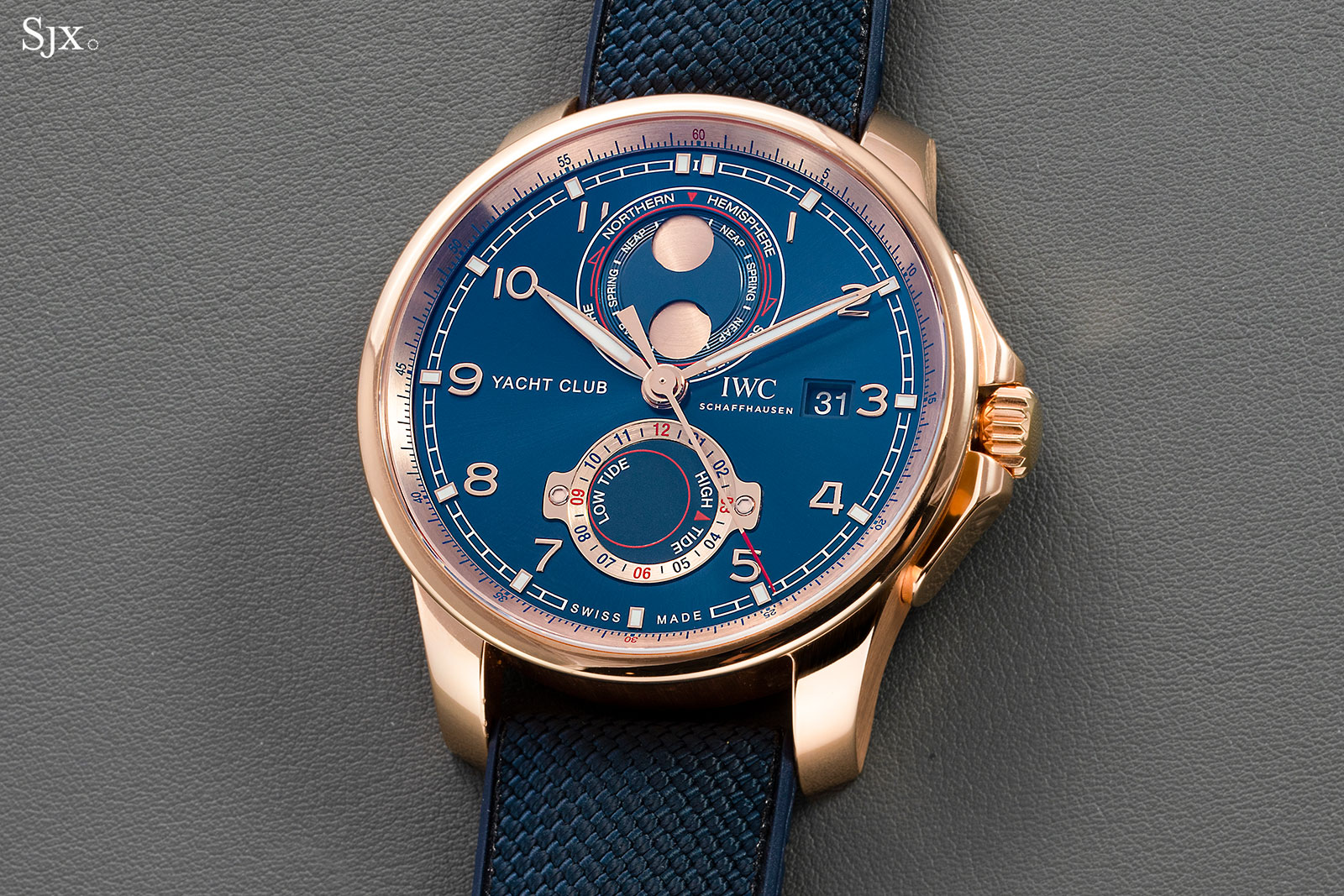
And because tides are dependent on the Moon, also integrated into the moon phase is the spring and neap tide indicator. The rim of the blue disc is marked with the periods of spring and neap tides, with a small, red arrow to indicate if the current period is a spring, neap, or ordinary tide.
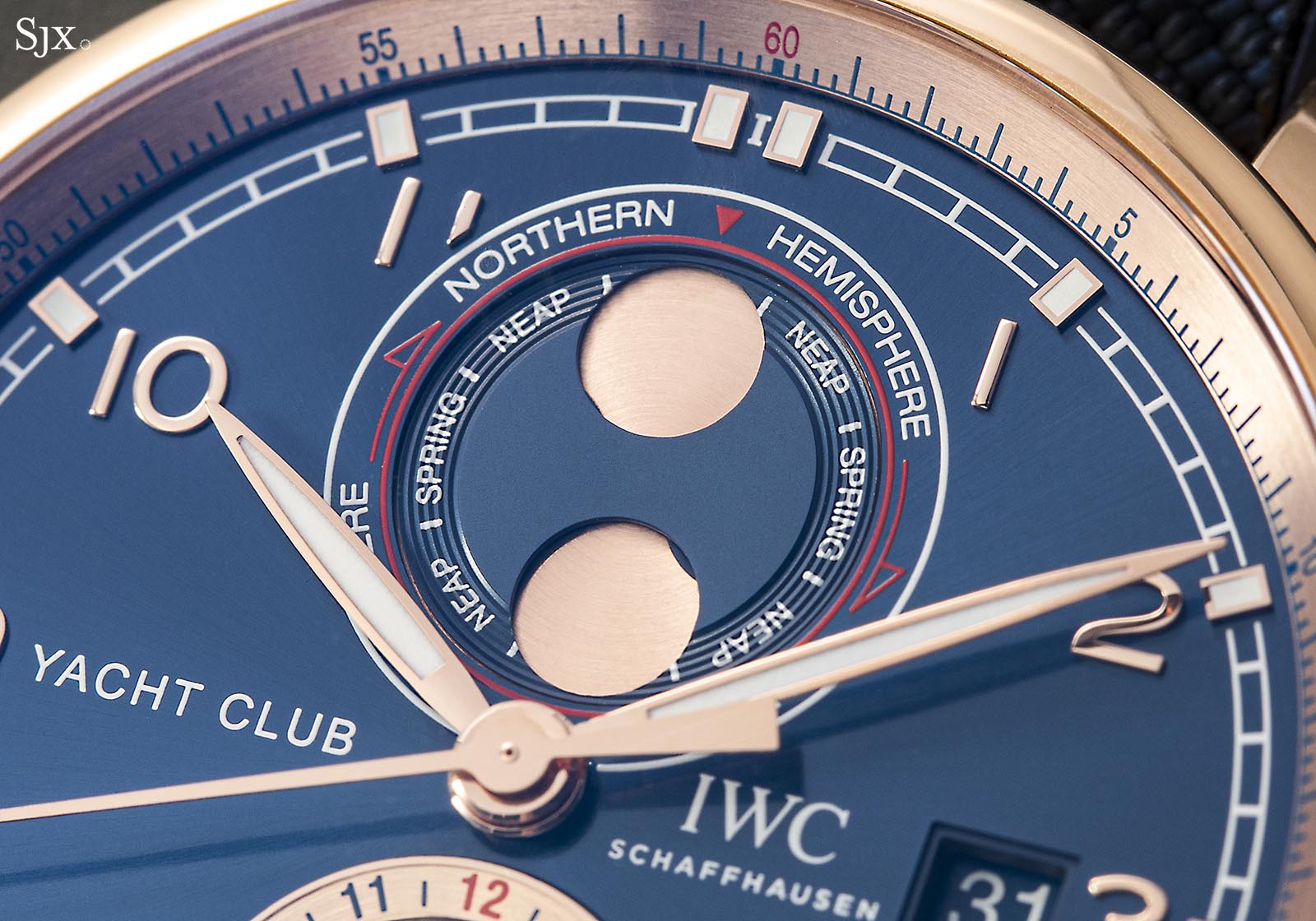
The tide indicator within the moon phase
The sub-dial at six o’clock has a 12-hour scale with a slowly-rotating disc that indicates the times for high and low tides at the current time. Featuring a red arrow for high tide and a red ring for low tide, the indicator travels at the leisurely pace of one rotation every 14.76 days, or half a lunar month.
The slow rotation of the tidal disc is driven by reduction gears in the tide-display mechanism that convert the motion of the hour pinion, which carries the hour hand makes logically makes two rotations a day. The reduction ratio of the mechanism is substantial, after 12 hours and 24 minutes, which is half a tidal day, the tide disc would have rotated just 24 minutes on the 12-hour scale. But though it moves slowly, the tide indicator is exceptionally precise. According to IWC, it will deviate by 10 minutes after one century.
Conveniently, the tide indicator is independent of the time display so the it can be set via the crown. But setting the tide display also reveals a minor drawback in its 12-hour, rather than a 24-hour, scale. When setting the watch, the only way to tell if it is day or night is the date change at midnight. But aesthetics no doubt justify this, as the tidal sub-dial indicator has larger markings and better legibility than if it were on a 24-hour scale.
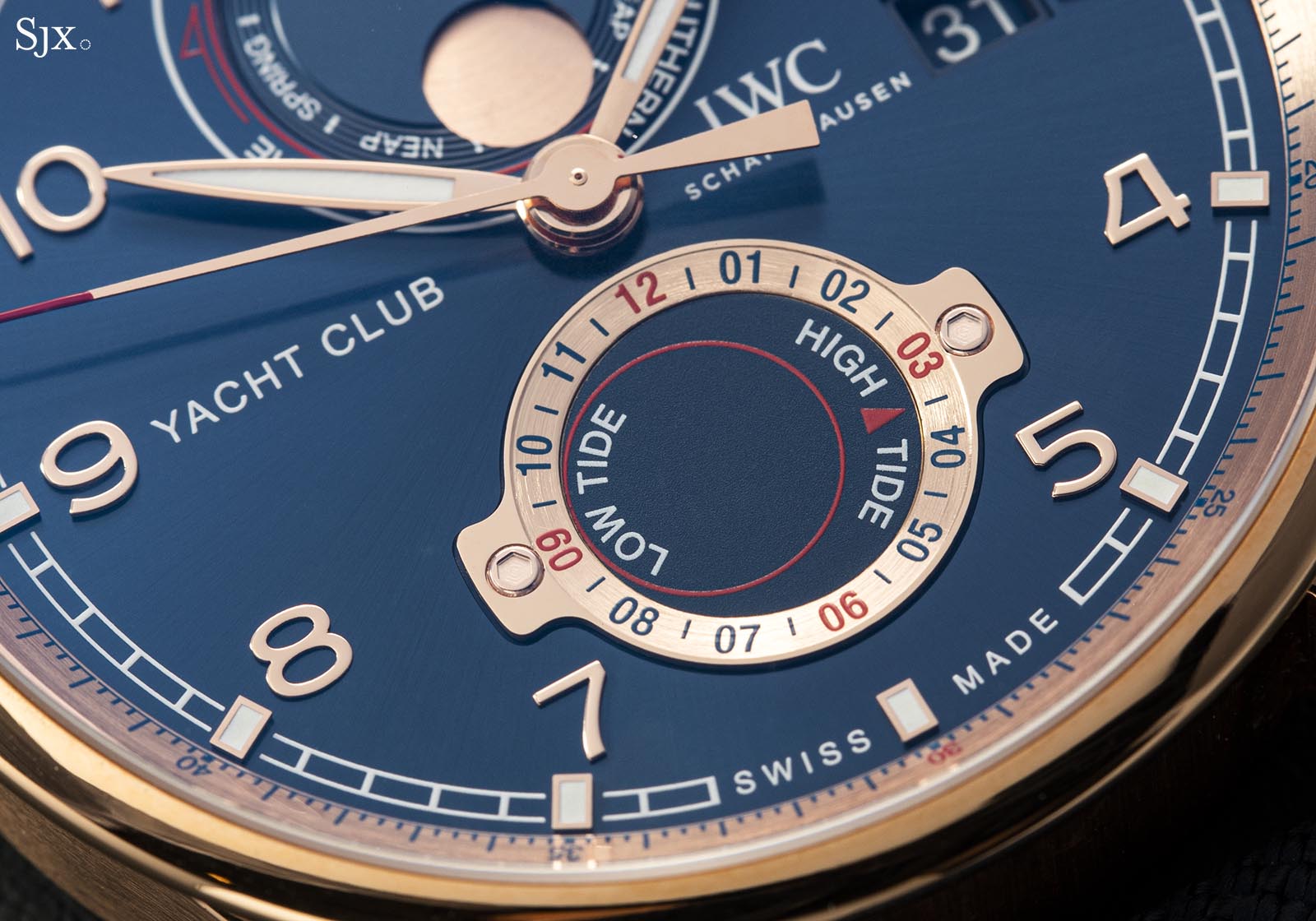
The tide indicator on a rotating disc, against a 12-hour scale, which shows high tide at about 3:30 and low tide at around 9:30.
The movement
The Yacht Club Moon & Tide is powered by the cal. 82835, made up of the cal. 82110 with the moon and tide module on top. Impressively, even with the added moon and tide displays, the movement has the same 60-hour power reserve as the unencumbered base movement.
Relatively compact but solidly-constructed and robust, the base movement is from IWC’s cal. 82000 family, which is related to the seven-day cal. 52000 and chronograph cal. 89000. The cal. 82000 is smaller than the cal. 52000, but the two share several features, most notably the Pellaton winding mechanism.
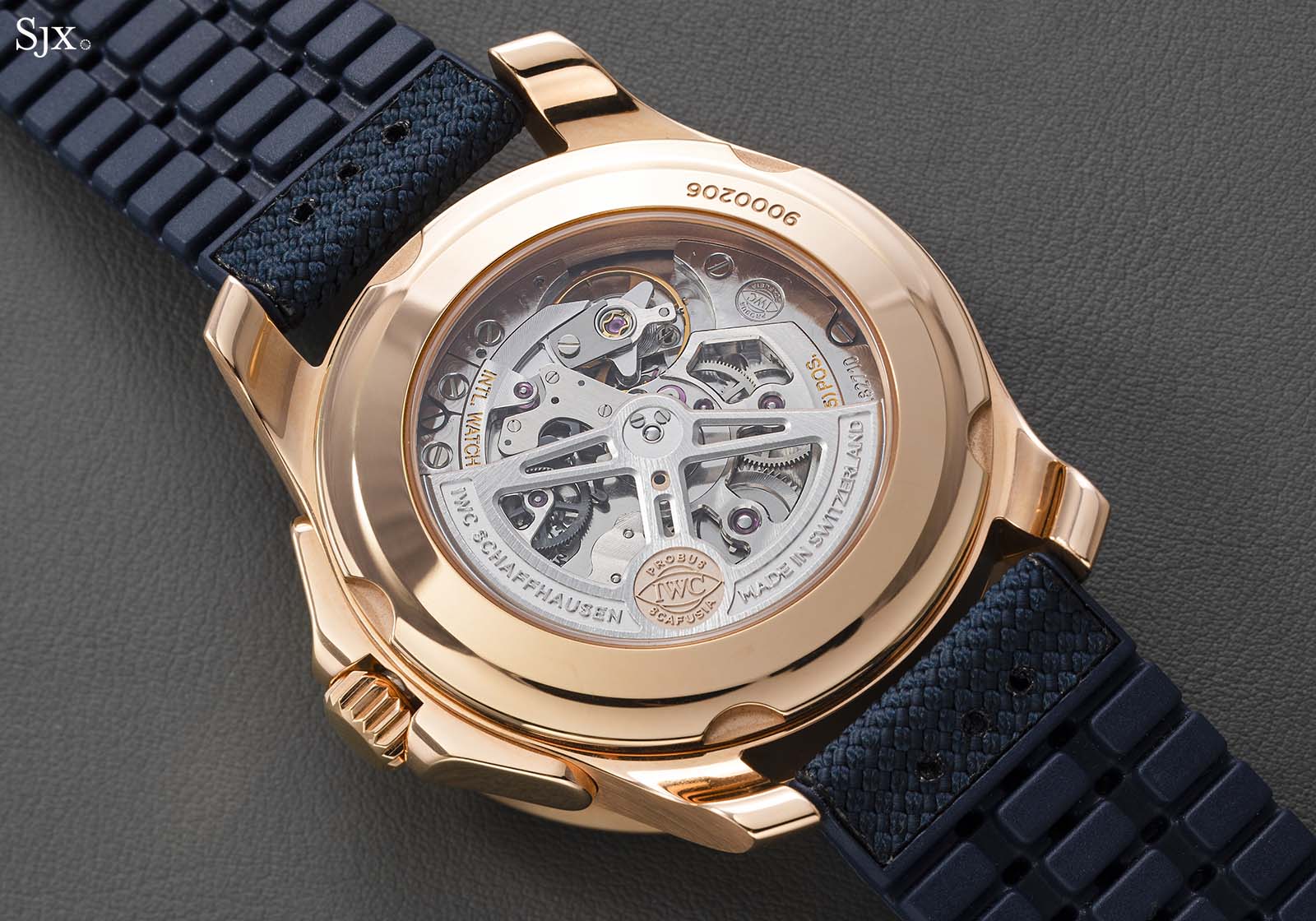
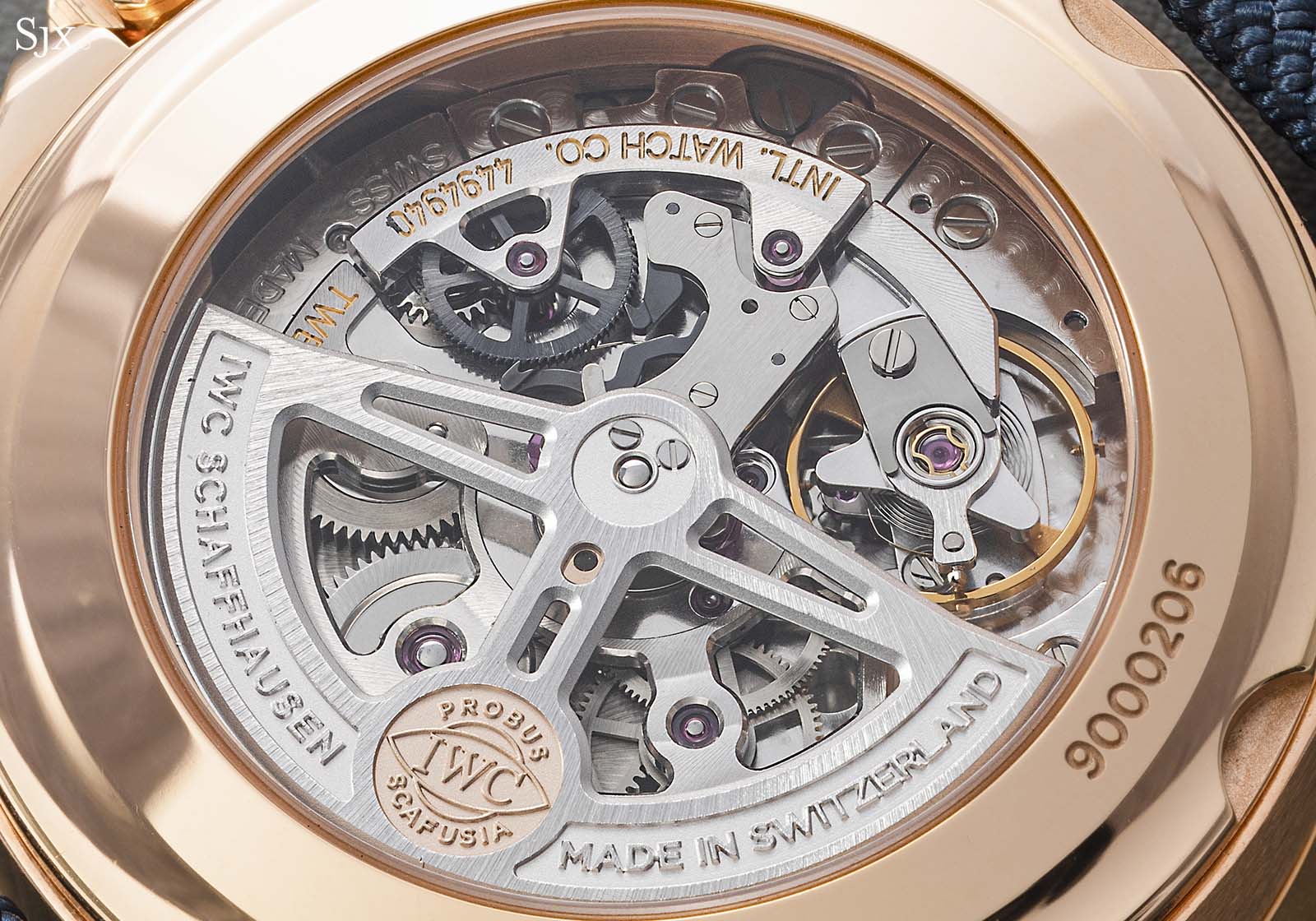
Invented by famed IWC watchmaker Albert Pellaton in 1946, the eponymous winding system centres on a heart-shaped cam driven by the winding rotor.
As the rotor turns, the cam oscillates the between two jewelled rollers mounted on a Y-shaped bridge. That causes the bridge to swing back and forth, transferring energy to a pair of attached pawls that push and pull against the teeth of the barrel ratchet wheel, winding the mainspring.
This iteration of the Pellaton system is the very latest, so the automatic wheel, pawls and cam are made of wear-resistant ceramic that needs no lubrication. In contrast, the simpler IWC movements, like the cal. 32000, utilise the “Magic Lever” type of mechanism with push-pull pawls.
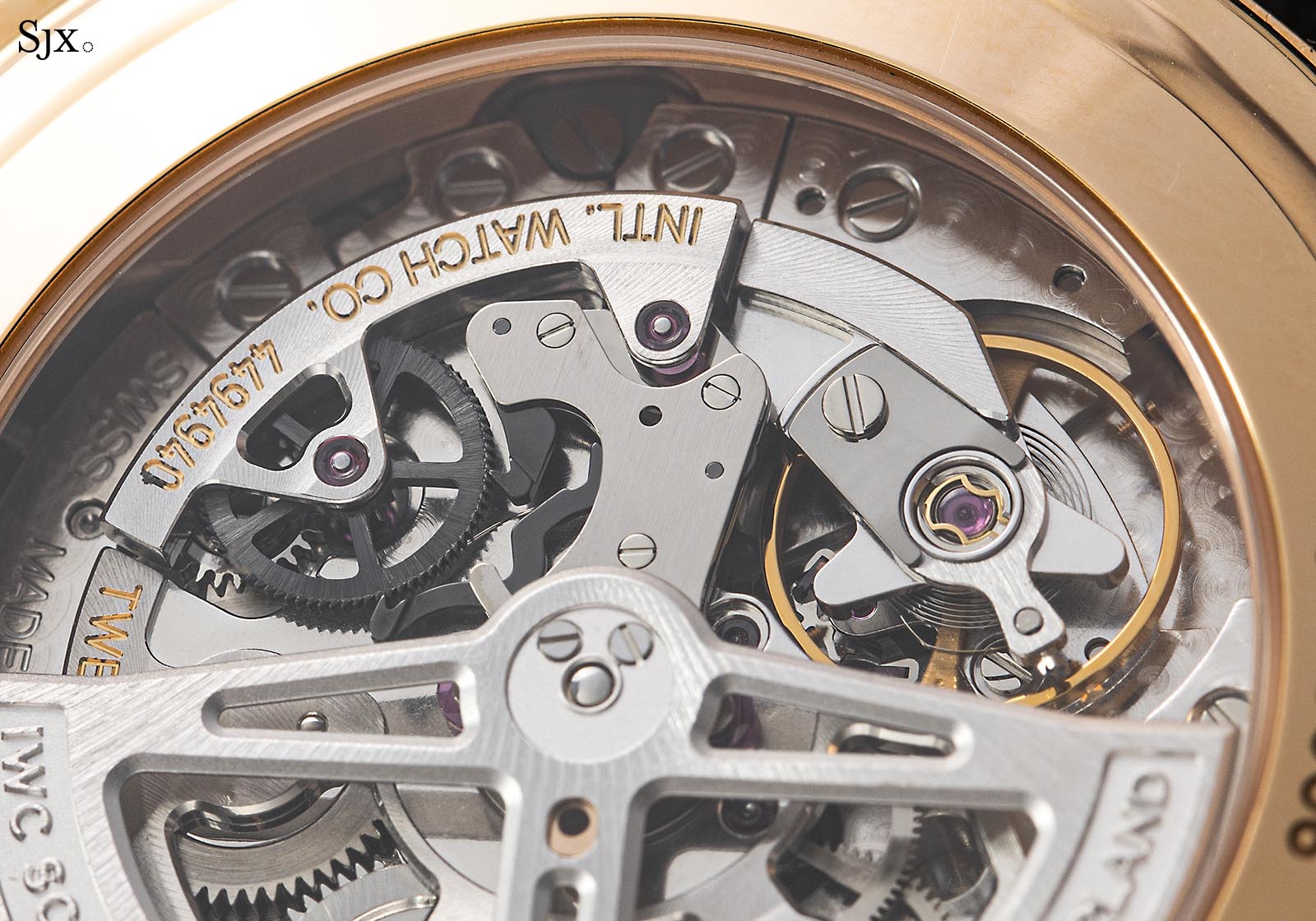
The Pellaton winding system (top left) with its ceramic wheel and pawls visible
In addition to the Pellaton winding mechanism, the movement also boasts a free-sprung, adjustable-mass balance, generally considered to be the most sophisticated type of balance wheel. And as with a majority of IWC movements, the balance is attached to an ordinary flat hairspring (only a handful of much-larger movements, such as the 8-day cal. 59000 and the four-day cal. 94000, feature an overcoil hairspring).
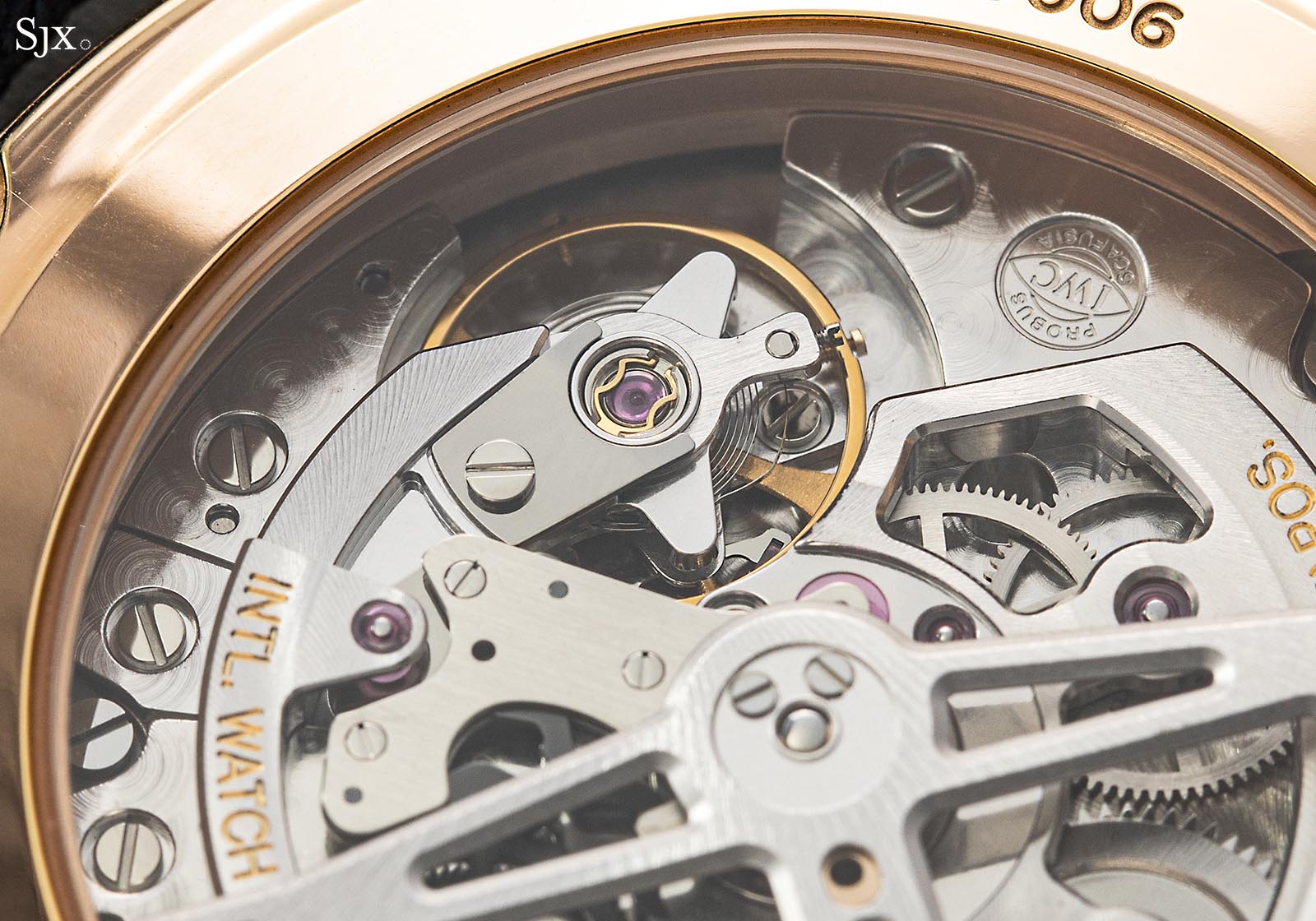
The free-sprung balance
Because the movement is relatively fancy for a moderately-sized, simple automatic, it was designed with aesthetics in mind, with the rotor and bridges partially skeletonised to reveal the mechanics. The barrel bridge for instance has two large apertures revealing the barrel, gear train, and of course the Pellaton mechanism.
The finishing of the movement is typical of IWC. Mechanically applied, but sharp and clean, likely sharper and cleaner than peers in the same price bracket. It also incorporates aesthetic details like the “Probus Scafusia” seal on the rotor and again the base plate, along with gold-plated engraving, which give it more colour. As a result, the movement is visually attractive.
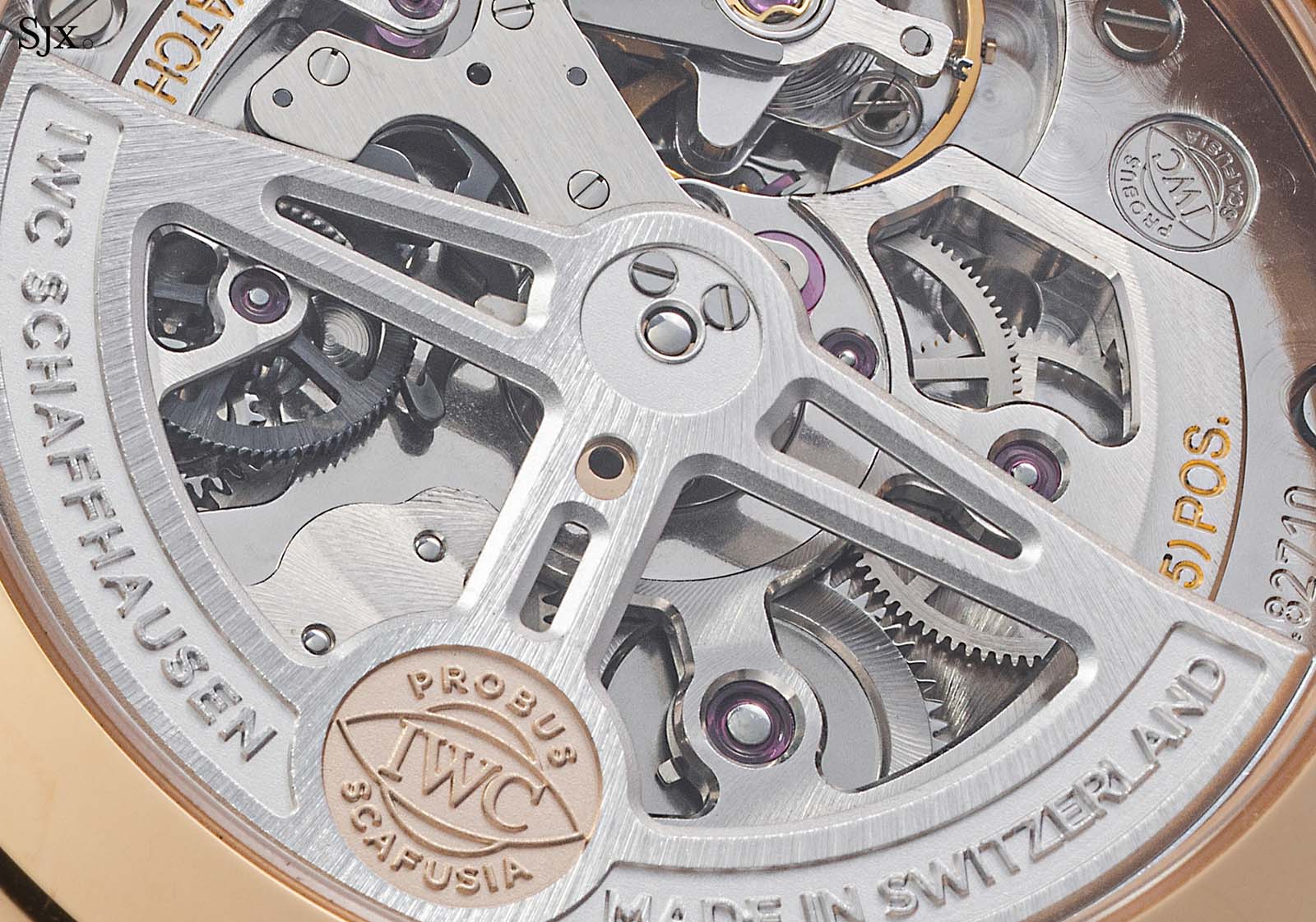
The skeletonised rotor with prominent bevelled edges
Concluding thoughts
Tide watches are truly off the beaten path of complications, making them unique in themselves. But the sophistication in design and execution of the Yacht Club Moon & Tide takes it a step further than its peers. The watch only has one real competitor, which is the Corum Admiral AC-One Tides. While the competition is sparse, the Yacht Club Moon & Tide edges ahead as it neatly combines the brand’s trademark moon phase with an all-inclusive tidal display.
The functionality of the Yacht Club Moon & Tide is essentially identical to the Corum Admiral AC-One Tides, but Yacht Club simplifies the tidal displays, making them more digestible for the layman user.
On the other hand, the Corum Tides displays the same information with more granularity, indicating tide levels on a 24-hour scale, and also tide strength on a numeral scale. That is doubtlessly more appealing to the specialist, but is probably too much for a watch enthusiast.
In terms of design, the Yacht Club trumps the Corum Tides, which is a chunky, brightly coloured watch that lacks the refined details of IWC’s wristwatch. And the Corum Tides also falls short in terms of mechanics, since it is powered an ordinary ETA 2892 base movement.
But, and this is important, the Corum Tides is available only in titanium, and is correspondingly affordable, with a price tag of under US$10,000, which is less than a third of the Yacht Club.
Consequently, the IWC is the top choice, but in the extremely rarefied realm of ultra high-end tide watches in precious metal cases. Being an interesting and unusual watch that is executed well, it really should be available in a steel or titanium. Fortunately, it probably will, going by IWC’s past practice.
Key facts and price
IWC Portugieser Yacht Club Moon & Tide
Ref. IW344001
Diameter: 44.6 mm
Height: 14.4 mm
Material: Pink gold
Water resistance: 60 m
Movement: Cal. 82835
Functions: Time; date; double-hemisphere moon phase; spring and neap tide indicator; and high and low tide display
Frequency: 28,800 beats per hour (4 Hz)
Power reserve: 60 hours
Strap: Blue rubber strap with textile inlay
Limited edition: No
Availability: At boutiques and retailers from November 2020
Price: 35,000 Swiss francs
For more, visit Iwc.com.
Correction April 29, 2020: The cal. 82000 family of movements is in-house, and related to the cal. 52000 and cal. 89000. It is not based on the architecture of the ETA 2892 as stated in an earlier version of the article. Additionally, the water-resistance of the watch is 60 m, and not 30 m.
Addition May 4, 2021: Heuer introduced the Seafarer in 1950.
Back to top.
